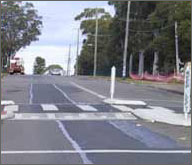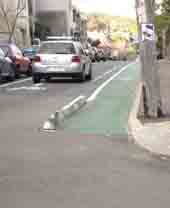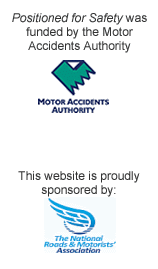Road Design

Safe design requires that road users must have sufficient time to be able to see, process and react to information.
The principles are the same for all road users, but the standards are more critical for motorcyclists as errors can have more severe consequences.
Intersection design
The majority (56%) of motorcycle crashes with another vehicle are at intersections, and most are due to the other driver failing to give way (80%). Campaigns to raise driver awareness are essential, but intersection design also plays a part. Intersections design, signage and landscaping should be uncluttered and provide a clear view to reduce distraction and confusion.
Advance stop lines (ASLs) for cyclists are provided in Melbourne and across Europe and Asia. ASLs have also recently been introduced for motorcyclists at large intersections in a number of countries (Belgium, Holland, Japan and Switzerland). Trials of shared ASLs for motorcyclists and cyclists have been successfully trialled in London.
Head-On zone
Head on crashes make up only 6% of motorcycle crashes, but 14% of fatal crashes. The majority are not due to overtaking but most (80%) are due to the motorcycle crossing the centre line usually on a curve (74%). In many cornering crashes, the motorcycle's wheels may have still been on or close to the correct side of the road, but the riders' body and head were over line. In some cases, the geometry of the corner has contributed to the rider's error, but all too often it would appear due to inexperience or misjudgement.
Vanishing point
Engineers in the UK have devised a way of using guide posts to give riders a better idea of their position and speed on bends. They place guide posts closer together and continue them further around the bend than is usual practice. Essentially the guide posts are used to take the rider's view right around the bend into the straight. It is a simple application of Where You Look is Where You Go (WYLIWYG). Since this system has been introduced in Buckinghamshire, there have been no reported motorcycle crashes on what was previously a notorious bend (Debell, 2007).
Engineering practice
According to the RMS (Road Environment Safety: A Practitioners Guide, 1996, section 3.3), a safe road environment should:
- Warn road users of any possible substandard features
- Inform road users of the type of unusual conditions that are likely to be encountered
- Guide road users through unusual sections of road
- Control road users through conflict points or areas of conflict
- Forgive errant road users inappropriate behaviour.
In addition a safe road design should:
- Provide no surprises
- Provide a controlled release of information
- Give consistent messages to road users.
This lack of mainstream engineering awareness of specific design issues for motorcyclists is disappointing, particularly as Australia led the world with the publication of a road engineers guide on motorcycle safety in 1999. Austroads issued a guide to road engineers on the design, construction and maintenance of roads and traffic devices to remove needless hazards and provide motorcyclists with an appropriately safe environment. Guide to Engineering Practice Part 15 - Motorcycle Safety
Part 15 was withdrawn by Austroads who now issue consolidated engineering Guides. The subject matter of Part 15 has been incorporated into "Various parts of Guide to Road Design and Guide to Traffic Management" See Road Design
The generic "mapping" of Part 15 to the new Guides is indexed here:
Austroads current Guides
Some state authorities have issued their own Guides as supplements, such as VicRoads Supplement
to the Austroads Guide to Road Design
Similar guidelines were issued only relatively recently in the UK and Europe (IHIE, 2005; ACEM, 2006).
The recommendations of Part 15 have yet to be incorporated into the procedures applied by most road authorities in NSW. Part 15 is a very useful resource for any motorcyclist who wants to learn more about road design standards for motorcycle safety and to be able to discuss such issues with their local road authority.
Unfortunately road authorities tend to make provisions for pedestrians and cyclists and subsume motorcyclists under the general category of 'motorists'. It remains to be seen whether road engineers will consider the needs of motorcyclists through the new consolidated Austroads Guides.
Some of the most common design hazards include:
- Adverse camber/ crossfall
- Blind corner
- Lack of appropriate warning
- Lack of clear zones
- Glare from poorly sited street lights
- Poor sight lines
- Speed hump
- Poor delineation of vehicle path
- Barrier kerbing
- Low kerbing
- Cobble stones or pavers
- Landscaping
- Traffic islands that are not lit or delineated for night visibility
- Culverts
- Uncovered drainage pits.

